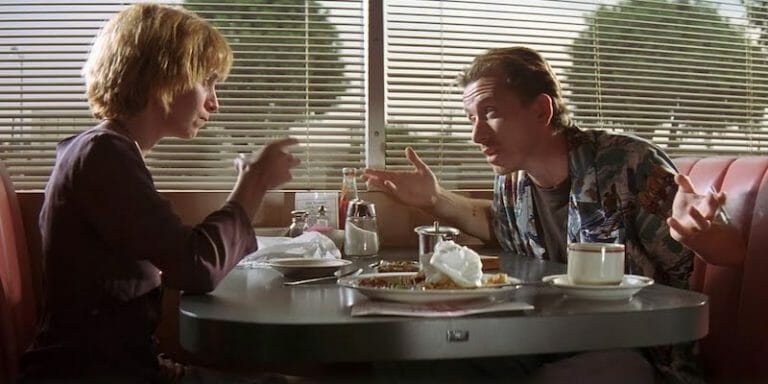By Ken Miyamoto · March 26, 2019

How does Quentin Tarantino craft his iconic dialogue scenes?
Welcome to our ongoing Learning from the Masters and Industry Insiders series where we seek out and feature excellent videos, interviews, and discussions of the art, craft, and business of screenwriting and pull the best words of wisdom, writing tips, and screenwriting advice.
Here we feature The Closer Look‘s How Tarantino Writes a Scene and share some of the best information that you can use to write better dialogue scenes.
The video refers to this common Tarantino method as The Pledge. It’s something that he often utilizes in his screenplays.
In Pulp Fiction, the opening scene’s dialogue begins with, “Forget it, it’s too risky.”
That immediately pledges to the audience that something interesting is going to happen and that there are big stakes ahead.
What’s the plan and why is it so risky?
Audiences are quickly engaged and stay tuned in to each and every word of dialogue within the scene because they know that sooner or later, something intriguing is going to happen.
Tarantino writes dialogue in a way that often serves the whole cinematic story. Each line of dialogue isn’t just there to present itself. It’s there to set up the overarching character development, plot, and story.
That is why it is so difficult to turn your attention away from every line of dialogue in a Quentin Tarantino movie. Every line truly matters.
With a few exceptions for each of his films, every scene, every moment, and every line of dialogue has conflict attached.
Whether it’s an argument, disagreement, confrontation, some form of danger, or a type of inner conflict that a character within the scene is dealing with, almost every scene and line of dialogue has something to do with some kind of conflict.
There is often something at stake in every scene of his movies. And that is what engages audiences and heightens the level of suspense.
Tarantino is a master of subtext, which centers around everything not said within the dialogue but implied in due part to what the audience and the characters know. As the video says, subtext is the difference between the words that come out of a character’s mouth and the thoughts that stay inside their head.
If characters always said what they truly feel, truly know, or truly think, movies would be boring. Tension, hilarity, suspense, and characterization are created through subtext in dialogue.
Watch the full video for examples of Tarantino’s subtext.
The video points out how well Tarantino uses dialogue to prolong suspense. His films often have dialogue scenes that utilize the aforementioned subtext that he’s mastered to build as much suspense as possible until the anticipation is at a boiling point.
Download Tarantino’s scripts here for free

The suspense in this scene is constantly building, but not a word of the dialogue centers on why they are there and what is about to happen. The characters know why they are there and the audience clearly sees that Jules and Vincent’s presence is clearly making the apartment’s occupants nervous, but the dialogue is used to prolong the tension, leading to this moment where the anticipation reaches the boiling point.
Dialogue — and the subtext within — can and should be used to prolong the audience’s anticipation. This can be used in dramas, action thrillers, suspense thrillers, horror flicks, and even comedies.
Watch the whole video for amazing elaboration and examples of these five methods that Quentin Tarantino uses in his dialogue scenes.
For all the latest from The Script Lab, be sure to follow us on Twitter, Facebook, and Instagram.
And become a member of TSL 360 to enjoy the LARGEST screenwriting education content library, featuring masterclasses, deep-dive interviews, and lectures from Academy Award-winning screenwriters, TV show-runners, producers, literary managers, agents, studio executives, and leading educators – all in one place.